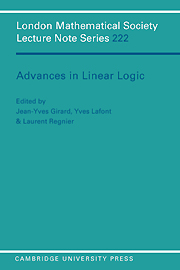Proof-nets and the Hilbert space
Published online by Cambridge University Press: 17 February 2010
Summary
Abstract
Girard's execution formula (given in [Gir88a]) is a decomposition of usual β-reduction (or cut-elimination) in reversible, local and asynchronous elementary moves. It can easily be presented, when applied to a λ-term or a net, as the sum of maximal paths on the λ-term/net that are not cancelled by the algebra L* (as was done in [Dan90, Reg92]).
It is then natural to ask for a characterization of those paths, that would be only of geometric nature. We prove here that they are exactly those paths that have residuals in any reduct of the λ-term/net. Remarkably, the proof puts to use for the first time the interpretation of λ-terms/nets as operators on the Hilbert space.
Presentation
λ-Calculus is simple but not completely convincing as a real machine-language. Real machine instructions have a fixed run-time; a β-reduction step does not. Some implementations do map-reductions into sequences of real elementary steps (as in environment machines for example) but they use a global time to achieve this. The “geometry of interaction” (GOI) is an attempt to find a low-level combinatorial code within which β-reduction could be implemented and such that:
elementary reduction steps are local;
parallelism shows up and global time disappears;
some mathematics dealing with syntax is uncovered.
— Goal and organization of this paper.
A persistent path is a path on a λ-term which survives the action of any reduction (defined in [Reg92]). A regular path is a path which is not cancelled by Girard's algebraic device L* (defined in [Gir88a]).
- Type
- Chapter
- Information
- Advances in Linear Logic , pp. 307 - 328Publisher: Cambridge University PressPrint publication year: 1995
- 40
- Cited by



